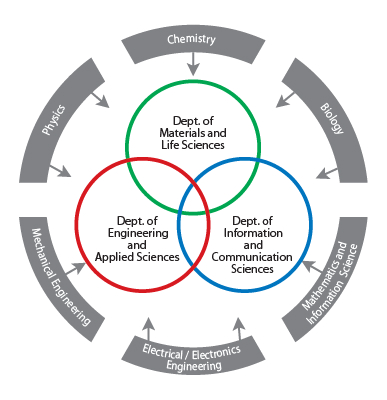A new era of science and technology serving the people and the planet
Students at the Faculty of Science and Technology of Sophia University are deeply immersed in their own areas of study while freely interacting with other fields to develop a sensitivity, knowledge, and ability to integrate these fields and move fluidly in thought between humanities and the sciences. The goal is to produce graduates with “crossdisciplinary knowledge” that enables them to participate in unraveling the complex problems challenging society today. The curriculum is grounded in the basics of science and technology while keeping up with the innovations and increasing diversity of industrial technology, enabling students to acquire a crossdisciplinary knowledge that includes the knowledge and wisdom of caring for people and the environment. To be able to fully leverage this crossdisciplinary knowledge, the students must understand the fundamentals of all areas of science and technology, and in order to be able to freely move between fields, each one must build a firm foundation in her or his own area of study. Thus, each department has key themes that indicate the scope of study and connect to the selection of a specialty. To build crossdisciplinary knowledge, students must select courses of study from among the numerous fields that are classified by these key themes and that are compatible with their primary field of interest. The small number of students typical of this university gives students ample access to professors to discuss the selection of courses and to decide the best path for their specialty. Students study scientific and engineering English to foster scientists and engineers who can be active on the international stage.

A faculty of Science and Technology that Serves People and the Environment– Integrated education in science and technology
This program offers integrated education in science and technology by bringing together the inquiry of science, the pragmatism of engineering, and the purposes of caring for people and the environment. To this end we have reduced the divide among the three new departments as much as possible to foster the ability to deal with the wild pace of change in science and technology and the diverse problems of society. We are providing interdisciplinary technical training with an awareness of the social significance of scholarship and science.
Relevance of existing study divisions to the specialist fields of the three new departments
The orthodox fields of study—such as mechanics, electricity, math, physics, chemistry, and biology—form the foundation of the new fields of study, and so the new fields inherit this traditional knowledge. As a result, physics and mathematics can be studied for the entire four years. Graduation research can also focus on existing study divisions or interdisciplinary divisions. In addition, existing fields of study are closely aligned with all post-graduate research divisions.
Cultivating a multi-dimensional perspective through robust education in the basics
The requirements for the first and second years are the same for each of the three departments. Classes in the first year are formed based on the degree of advancement and are meticulously executed. In addition to lectures, there are many experiments, exercises, and other activities, to ensure focus and interaction with the faculty and to leverage Sophia’s tradition of small-group education. We provide crossdisciplinary education covering science and engineering topics such as intellectual property rights and technology and management.
Providing a robust English education
English classes are required in all programs and are separated into different skill levels. In addition, the department’s curriculum includes classes for scientific and engineering English. By systematically teaching science and engineering in English, we are preparing students to be competitive scientists and engineers on the international stage.
Comprehensive guidance in choosing a path, only available with the small class sizes of private universities
Our system allows the students to create a customized course of study that enables them to choose their own path. While this provides a large degree of freedom, it is also a great source of uncertainty. Thus, we have provided “key themes” for each department that define the scope of study for each course and can help connect each course to the selection of a specialty. Through our tutoring system, students can consult one-on-one with faculty and thus select the right courses and the path to their specialty. This detailed program navigation is made possible through Sophia’s small class sizes. Each academic year, there are three to four senior students per faculty member, so each student gets the personal guidance that he or she needs.










 Materials and Life Science
Materials and Life Science
 Engineering and Applied Sciences
Engineering and Applied Sciences
 Information and Communication Sciences
Information and Communication Sciences
